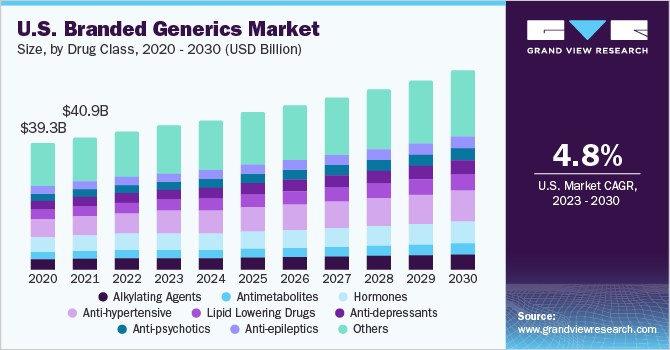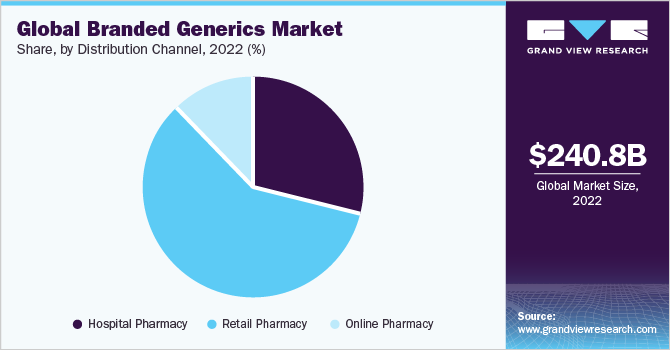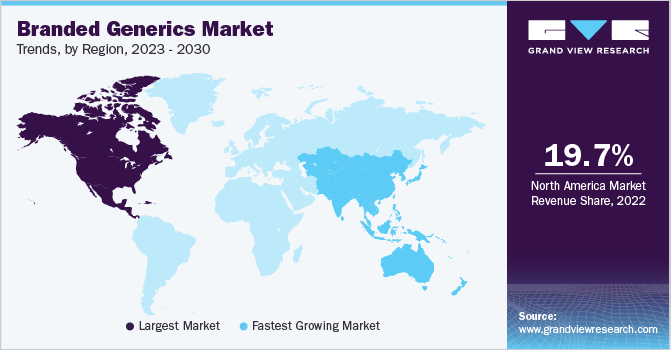- Home
- »
- Pharmaceuticals
- »
-
Branded Generics Market Size, Share, Growth Report, 2030GVR Report cover
![Branded Generics Market Size, Share & Trends Report]()
Branded Generics Market (2023 - 2030) Size, Share & Trends Analysis By Drug Class (Alkylating Agents, Antimetabolites, Anti-Hypertensive), By Application, By Route Of Administration, By Distribution Channel, By Region, And Segment Forecasts
- Report ID: GVR-4-68039-943-5
- Number of Report Pages: 155
- Format: PDF
- Historical Range: 2018 - 2021
- Forecast Period: 2023 - 2030
- Industry: Healthcare
- Report Summary
- Table of Contents
- Interactive Charts
- Methodology
- Download FREE Sample
-
Download Sample Report
Branded Generics Market Summary
The global branded generics market size was estimated at USD 240.75 billion in 2022 and is expected to reach USD 375.95 billion by 2030, growing at a compound annual growth rate (CAGR) of 5.7% from 2023 to 2030. Rising prevalence of chronic diseases, increasing penetration of branded generic drugs, increasing government initiatives to promote generic products, and patent expiry of major drugs are some of the primary growth drivers.
Key Market Trends & Insights
- North America accounted for the share of 19.66% of the global market in 2022.
- By drug class, the anti-hypertensive segment dominated the marketspace in 2022 with a revenue share of 15.69%.
- By application, oncology is projected to witness the fastest growth with the CAGR of 6.2% by 2030.
- By route of administration, the oral segment accounted for the largest revenue share of 59.3% in 2022.
Market Size & Forecast
- 2022 Market Size: USD 240.75 Billion
- 2030 Projected Market Size: USD 375.95 Billion
- CAGR (2023-2030): 5.7%
- North America: Largest market in 2022
- Asia Pacific: Fastest grwing market
The expiry of patent exclusivity of innovator drugs provides opportunities to generic manufacturers to introduce products at a reduced price. The low cost of generic drugs increases patients' affordability and helps reduce healthcare expenditure per capita. For instance, as the U.S. patent exclusivity period of Bristol-Myers Squibb Company proprietary Sprycel (Dasatinib) has ended in 2020, generic companies such as Apotex and Dr. Reddy's Laboratories have filed ANDA for the launch of generic versions of the product.
Moreover, high ANDA approvals and the launch of generic products is another crucial factor supporting market growth. According to the FDA annual report, in 2021 FDA approved 93 first generics, which was 72 in 2020. However, it can be observed that the number of ANDA approvals decreased from 1,014 in 2019 to 948 in 2020, and further decreased to 776 in 2021. Such a decrease in the trend of ANDA approvals for generic drugs could impede industry growth.
The market has been moderately impacted by the COVID-19 pandemic. Amid the pandemic, a slowdown and disruption in the supply of pharmaceuticals was observed, due to the strategies designed to control the spread of the pandemic. In addition, regulatory operations were also affected, such as the authorization and Health Technology Assessment process has slowed down. Decisions on reimbursements have been de-prioritized. It also affected drug prescription and uptake rate moderately. For instance, in the UK according to NHS, approximately 20 million antidepressant medications were prescribed in March 2021; in January 2021, it was around 20.5 million. However, the impact of COVID-19 reduced significantly by the end of 2020 in most countries. Whereas in some countries affected by the third wave of COVID-19, the effect lasted until the third quarter of 2021.
The growing burden of non-infectious & infectious diseases and the growing geriatric population, which is more susceptible to chronic diseases, such as hypertension, diabetes, and obesity, is anticipated to positively impact the space growth. There were 537 million patients suffering from diabetes in 2021 globally. The prevalence rate of diabetes is growing rapidly in low- and middle-income countries. According to International Diabetes Federation data of 2021, approximately 643 million people will be suffering from diabetes by 2030 and 783 million by 2045.
Companies are introducing novel products to strengthen their product portfolio. For instance, in April 2020, Dr. Reddy's Laboratories Ltd. introduced Invista in India. This product is the branded generic version of Sprycel (dasatinib) indicated for the treatment of adult patients with Chronic Myeloid Leukemia (CML).
Drug Class Insights
The anti-hypertensive segment dominated the marketspace in 2022 with a revenue share of 15.69% due to the rising ANDA approvals and product launches over the past few years. For instance, in June 2019, Teva Pharmaceuticals Industries Ltd. and Hikma Pharmaceuticals PLC introduced the generic version of Tracleer in the U.S.
Hormones segment is anticipated to grow at a high growth rate due to rising investments to develop value-added or complex generics. Increasingly sedentary lifestyle has led to an increase in the prevalence of metabolic disorders. These disorders include thyroid and sexual hormone imbalance.
Application Insights
Oncology is projected to witness the fastest growth with the CAGR of 6.2% by 2030 due to the patent expiry of key drugs. Increasing disease burden may also contribute to the market growth. According to WCRF International, in 2020, there were an estimated 18.1 million cancer cases globally, of which, 9.3 million cases were among men and 8.8 million cases were among women.
The gastrointestinal diseases segment is expected to grow at moderate CAGR over the forecast period due to increasing prevalence of GI diseases. An NCBI article suggests that around 113 million prescription proton pump inhibitors were sold globally in 2020.
Route Of Administration Insights
The oral segment accounted for the largest revenue share of 59.3% in 2022 in the branded generics market, due to several advantages of oral dosage over other forms, such as ease of administration and no nursing requirements, thus leading to higher patient acceptability and compliance.
Moreover, the parenteral segment is expected to witness the fastest growth over the forecast. An increase in the prevalence of target diseases, such as cancer, hepatitis C, multiple sclerosis, and others, has resulted in high demand for generic injectables. This segment covers chemotherapy agents, small molecule antimicrobials, insulin, and peptide hormones among others.
Distribution Channel Insights
The retail pharmacy distribution channel segment held the highest share of 58.6% in the market in 2022. This can be attributed to growing burden of chronic diseases and the various discounts offered by retail pharmacies. The market has witnessed consolidation in retail pharmacy chains in the U.S. Moreover, the hospital pharmacies segment is expected to show moderate growth. Injectable drugs account for a significant proportion of the hospital pharmacy sales.

On the other hand, the hospital pharmacies segment is expected to show moderate growth during the forecast period. Injectable drugs account for a significant proportion of hospital pharmacy sales.
Regional Insights
North America accounted for the share of 19.66% of the global market in 2022 and is expected to grow with a slow growth rate over the forecast period. Moderately high penetration of branded generic drugs and the growing disease burden and geriatric population are among the factors driving growth.

Asia Pacific market is expected to grow at the highest CAGR during the forecast period. The increasing penetration of products in countries such as Japan and India is expected to be major growth drivers. In addition, countries in this region are focusing on the development of their manufacturing hubs to tackle the shortage of life-saving medicines, addressing the unmet needs. In countries such as India, the doctors prescribe drugs using brand names instead of INN and hence there is a higher demand for branded generics in this region.
Key Companies & Market Share Insights
Players leverage agreements and partnership strategy to increase their production capabilities and promote the reach of their product offerings. For instance, In March 2023, the United Nations-backed Medicines Patent Pool (MPP) has granted Viatris, Inc., Aurobindo Pharma, and Cipla Inc. sublicenses to make low-cost branded generic versions of Apretude, an HIV drug manufactured by GSK plc. ViiV, a company established by a joint venture of GSK plc. and Pfizer Inc., will help the companies with the development, production, and supply of the branded generic versions. Some of the prominent players in the global branded generics market include:
-
Teva Pharmaceutical Industries Ltd.
-
Lupin
-
Sanofi
-
Sun Pharmaceutical Industries, Ltd.
-
Dr. Reddy's Laboratories Ltd.
-
Endo International plc
-
GlaxoSmithKline plc
-
Pfizer, Inc.
-
Apotex, Inc.
-
Viatris, Inc.
Branded Generics Market Report Scope
Report Attribute
Details
Market size value in 2023
USD 253.39 billion
Revenue forecast in 2030
USD 375.95 billion
Growth rate
CAGR of 5.7% from 2023 to 2030
Base year for estimation
2022
Historical data
2018 - 2021
Forecast period
2023 - 2030
Report updated
May 2023
Quantitative units
Revenue in USD billion, and CAGR from 2023 to 2030
Report coverage
Revenue forecast, company ranking, competitive landscape, growth factors, and trends
Segments covered
Drug class, application, route of administration, distribution channel, region
Regional scope
North America; Europe; Asia Pacific; Latin America; MEA
Country scope
U.S.; Canada; Germany; U.K.; France; Italy; Spain; Denmark; Sweden; Norway; China; Japan; India; Australia; South Korea; Thailand, Brazil; Mexico; Argentina; South Africa; Saudi Arabia; UAE; Kuwait
Key companies profiled
Teva Pharmaceutical Industries Ltd.; Lupin; Sanofi; Sun Pharmaceutical Industries, Ltd.; Dr. Reddy's Laboratories Ltd.; Endo International plc; GlaxoSmithKline plc; Pfizer, Inc.; Apotex, Inc.; Viatris, Inc.
Customization scope
Free report customization (equivalent up to 8 analyst's working days) with purchase. Addition or alteration to country, regional & segment scope.
Pricing and purchase options
Avail customized purchase options to meet your exact research needs. Explore purchase options
Global Branded Generics Market Report Segmentation
This report forecasts revenue growth and provides an analysis on the latest trends in each of the sub-segments from 2018 to 2030. For the purpose of this report, Grand View Research has segmented the global branded generics market report on the basis of drug class, application, route of administration, distribution channel, and region:
-
Drug Class Outlook (Revenue, USD Billion, 2018 - 2030)
-
Alkylating Agents
-
Antimetabolites
-
Hormones
-
Anti-hypertensive
-
Lipid Lowering Drugs
-
Anti-depressants
-
Anti-psychotics
-
Anti-epileptics
-
Others
-
-
Application Outlook (Revenue, USD Billion, 2018 - 2030)
-
Oncology
-
Cardiovascular Diseases
-
Neurological Diseases
-
Gastrointestinal Diseases
-
Dermatological Diseases
-
Acute And Chronic Pain
-
Others
-
-
Route Of Administration Outlook (Revenue, USD Billion, 2018 - 2030)
-
Topical
-
Oral
-
Parenteral
-
Others
-
-
Distribution Channel Outlook (Revenue, USD Billion, 2018 - 2030)
-
Hospital Pharmacy
-
Retail Pharmacy
-
Online Pharmacy
-
-
Regional Outlook (Revenue, USD Billion, 2018 - 2030)
-
North America
-
U.S.
-
Canada
-
-
Europe
-
Germany
-
UK
-
France
-
Italy
-
Spain
-
Denmark
-
Sweden
-
Norway
-
-
Asia Pacific
-
Japan
-
China
-
India
-
Australia
-
South Korea
-
Thailand
-
-
Latin America
-
Brazil
-
Mexico
-
Argentina
-
-
Middle East And Africa (MEA)
-
South Africa
-
Saudi Arabia
-
UAE
-
Kuwait
-
-
Frequently Asked Questions About This Report
b. The global branded generics market size was valued at USD 240.75 billion in 2022 and is anticipated to reach USD 253.39 billion in 2023.
b. The global branded generics market is expected to witness a compound annual growth rate of 5.7% from 2023 to 2030 to reach USD 375.95 billion by 2030.
b. Based on route of administration, the oral segment held the largest share of 59.29% in 2022, owing to a high preference for oral dosage form due to ease of use and a higher number of approved products.
b. Some key players operating in the branded generics market include Teva Pharmaceutical Industries Ltd.; Lupin; Sanofi; Sun Pharmaceutical Industries, Ltd.; Dr. Reddy's Laboratories Ltd.; Endo International plc; GlaxoSmithKline plc; and Pfizer, Inc.amongst others
b. Key factors driving the branded generics market growth include rising penetration of branded generic products, patent expiry of key drugs, and rising prevalence of chronic diseases.
Share this report with your colleague or friend.
Need a Tailored Report?
Customize this report to your needs — add regions, segments, or data points, with 20% free customization.

ISO 9001:2015 & 27001:2022 Certified
We are GDPR and CCPA compliant! Your transaction & personal information is safe and secure. For more details, please read our privacy policy.
Trusted market insights - try a free sample
See how our reports are structured and why industry leaders rely on Grand View Research. Get a free sample or ask us to tailor this report to your needs.










